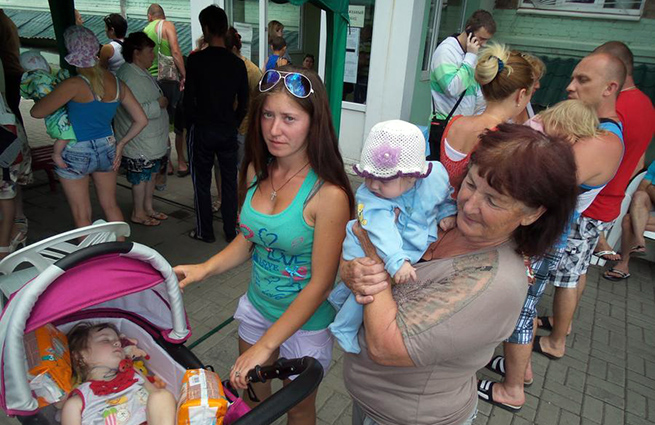While the world focuses on refugees arriving in Europe from warzones in the Middle East, the plight of those fleeing war in Ukraine has been forgotten.
By Sara Cincurova. Published 11-10-2015 at openDemocracy

Photo via reflexion-shades
Across the world people are concerned by the current European refugee crisis, however there are thousands of Ukrainians who have fled war in their own country and are now living as refugees on the borders of Eastern Europe. Their destinies remain overlooked and unknown.
The very Western parts of Ukraine have become home to several thousand refugees who have fled the armed conflict in Donbas; some of them are now living no further than two kilometres from the EU border. They have fled the war, traveled thousands of kilometres, lost their loved ones and risked their lives so that they can get closer to European borders. Unlike those who have crossed the Mediterranean Sea, however, Ukrainian refugees know that entering Europe is impossible for them – no matter how close it may be.
“I would like to go and visit my family in the East of Ukraine”, confesses Misha, a refugee who has been on the run with his wife and three children for more than a year, “but my priest wouldn’t let me go. He says I am going to get killed straight away”.
Misha’s mother, like many other elderly people, stayed in Donbas; she was unable to flee the war. Misha is still waiting for the blessing of his priest so that he can go and visit her.
Most families that have moved towards Western Ukraine are now homeless in their own country. They do not have the possibility to proceed any further West since the EU borders are impossible to cross. Their only other alternative would be to make a U-turn, cross the country once again and move to Russia or Belarus, which is often not a viable solution.
Altogether, more than two million people have been forced to leave their homes since the beginning of the armed conflict. While the situation of migrants in Serbia, Hungary and other surrounding countries is the subject of much focus and debate across social, political and media discourse all around Europe, the refugees living only a few kilometres northeast of the European borders have almost no help available to them at all. Most people simply don’t know about them. They have become internally displaced persons or “IDPs”; refugees in their own country.
Uzhgorod, a town on the Slovak-Ukrainian border is full of families on the run who live in conditions that are similarly precarious to the ones encountered by refugees arriving in other European countries. “We had to leave everything behind and run“, explains Svetlana, who escaped with her elderly mother and two sons, aged nine and eleven. Her husband decided to stay in the Donbas region so that he could carry on earning money. It is now too late for him to change his mind; he is no longer able to leave the war zone that has been surrounded by soldiers.
“Our life is an infinite dilemma: we have lost everything over there, and here, we have got nothing at all,” Svetlana says. The whole family – grandmother, mother and children – are now sharing a 15 metre square hotel room. They have been living in the hotel for more than a year now – without a kitchen, without enough beds and without a fridge or a washing machine to use.
Some IDPs with nowhere to go are forced to live in tents, gardens or lodges. Others live in hotels: just like Svetlana and her relatives, entire families of five, six or seven people have been sharing single rooms for a year. Some of the hotels in the region allowed the refugees to settle in at the beginning of the conflict, however, most of them didn’t realise that it was going to last months, or even years.
Many families have been divided, since most of the elderly or ill were unable to flee the war zones. In the meantime, new technologies have become crucial for keeping contact. Some of the children born on the run have only seen their fathers through Skype: many of the men have chosen to stay in the East of the country. Their children have become used to being raised through webcams.
There is very little help available in the far western parts of the country since there is no urgent humanitarian crisis taking place there. The situation, therefore, remains largely unknown to many Europeans. In Slovakia, a crowd-funding campaign is being run by local NGO Usmev ako dar, which believes that Slovaks can, and should, help Ukraine as their neighbouring country. This, however, is one of very few initiatives trying to raise awareness of the situation in Ukraine.
Even though cities like Uzhgorod are almost 1500 kilometers away from the zones of conflict and only two kilometres away from the EU border, they are now home to several thousand refugees: the exact numbers are impossible to estimate since a significant number of male refugees are in hiding. With the country the way that it is, it is safer to keep their whereabouts unknown.
Sara Cincurova is a freelance journalist focusing on human rights. She is a former family support worker and holds a Master’s degree from the Paris Descartes – Sorbonne University.
This article is published under a Creative Commons Attribution-NonCommercial 4.0 International licence.

